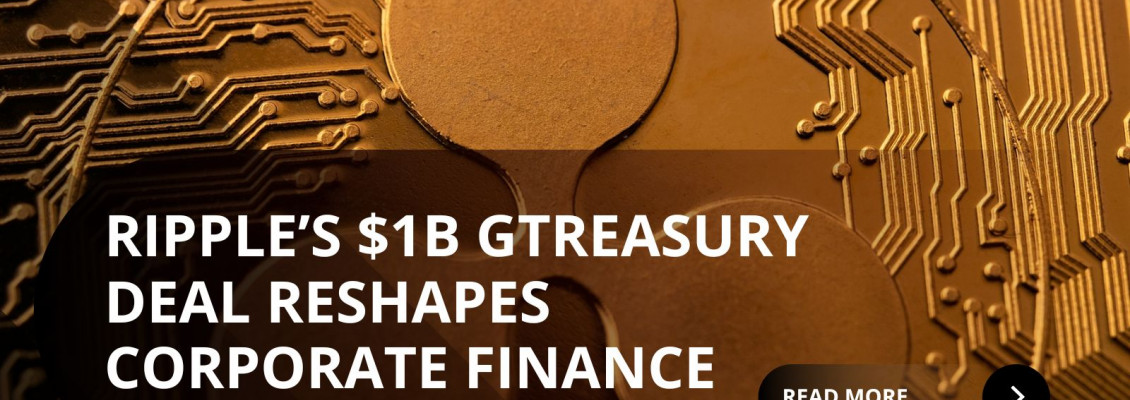
In a strategic leap bridging DeFi and traditional finance, Ripple has acquired GTreasury for $1 billion — a move that creates a direct pipeline for its regulated stablecoin RLUSD into Fortune 500 treasuries and institutional finance. The implications are huge: unlocking idle capital, enabling 24/7 liquidity, and embedding digital assets into core corporate finance tools.
Here’s a full walkthrough of what this means — and why it matters.
What Exactly Happened
-
Ripple announced it would acquire GTreasury, a leading treasury management software firm, valued at about $1 billion.
-
GTreasury offers SaaS solutions used by corporations to manage cash, liquidity, risk, foreign exchange, and forecasting.
-
By folding GTreasury into its stack, Ripple gains access to its client base (including large enterprises and Fortune 500s), as well as compliance infrastructure, finance tooling, and corporate relationships.
-
The acquisition positions RLUSD — Ripple’s regulated, USD-backed stablecoin — to serve as the settlement asset for tokenized treasuries and capital flows within corporate finance.
-
The deal is pending regulatory approvals and is expected to close in the coming months.
Why This Is a Big Deal
1. RLUSD Gains a Fast Lane into Big Finance
One of the central narratives is that this acquisition accelerates the ability for RLUSD to enter the strategic treasury flows of large companies. This has been a goal echoed in earlier analyses: that RLUSD’s real promise is as a bridge between onchain capital and corporate finance.
The GTreasury acquisition gives Ripple the infrastructure and relationships necessary to embed RLUSD into real-world liquidity systems and cash management workflows.
2. Tokenized Treasuries Take Off on XRPL
Ripple has also pushed forward on deploying tokenized U.S. Treasuries on the XRP Ledger (XRPL). For example:
-
Ondo Finance’s OUSG (short-term US government treasuries) is now live on XRPL, letting qualified purchasers mint and redeem securities using RLUSD onchain, around the clock.
-
This integration demonstrates the functioning bridge: tokenized treasuries becoming accessible via RLUSD settlement — making treasury assets move with the speed, composability, and liquidity of crypto instruments.
-
RLUSD is now active in tokenized treasury markets via partnerships (e.g. with Securitize), enabling instant settlement, atomic transfers, and 24/7 liquidity.
These developments show the ambition: not just to build DeFi primitives, but to make core finance assets programmable, liquid, and interoperable.
3. Corporate Treasury Adoption of XRP Crosses $1B
This move also occurs in the context of growing corporate adoption of XRP in treasuries:
-
Several publicly traded firms have announced plans to raise capital to build XRP-centered treasury reserves, with total commitments nearing $1 billion.
-
Singapore’s Trident Digital (a Nasdaq-listed firm) aims to raise $500 million to house XRP in its treasury, staking its future on the Ripple ecosystem.
-
Other companies across sectors — energy, logistics, fintech — are quietly setting aside capital for XRP allocations as part of treasury diversification strategies.
Such adoption signals increasing institutional confidence in XRP’s role beyond speculation, as a working building block of corporate capital management.
4. A Strategy of Stacking Acquisitions
This is not Ripple’s first major move in 2025:
-
Earlier, Ripple acquired Hidden Road, a prime brokerage firm, for ~$1.25 billion.
-
It also acquired Stellar Rail, a payments/stablecoin infrastructure platform.
The GTreasury acquisition fits into a coherent vision: build out a full-stack, enterprise-focused financial infrastructure combining payments, capital markets, and treasury tooling.
Key Risks & Challenges to Watch
While the potential is significant, there are real challenges ahead:
-
Regulatory approval: The deal must navigate securities, fintech licensing, and national oversight in multiple jurisdictions.
-
Integration complexity: Merging GTreasury’s legacy systems and client relationships with Ripple’s blockchain-based stack is nontrivial.
-
Trust & adoption friction: Convincing legacy treasurers to adopt RLUSD and onchain tools over trusted systems will take time and proof.
-
Volatility & reserve mechanics: RLUSD must maintain stability and credible reserves (e.g. U.S. Treasuries, cash) to function as a safe settlement asset.
-
Competition & standards: Other stablecoins, tokenized asset platforms, and blockchain infrastructure providers are racing toward similar goals.
What to Watch Next
Here are the near-term developments to monitor:
-
Closing of the GTreasury acquisition and how Ripple integrates its client base into RLUSD flows
-
Expansion of tokenized treasury products on XRPL, and how many institutions adopt minting/redeeming via RLUSD
-
How RLUSD’s reserves and backing evolve — how much in U.S. Treasuries, cash, etc.
-
Corporate announcements from Fortune 500 / large CFOs adopting RLUSD-based treasury operations
-
Regulation or guidance from U.S. and global authorities concerning stablecoins, treasury operations, and tokenized securities
The Bigger Picture
Ripple is signaling its ambition to be more than a payments provider or blockchain infrastructure. It now aims to be a core participant in enterprise finance. By acquiring GTreasury, emphasizing RLUSD liquidity, and pushing tokenized treasuries live, it’s banking on bridging TradFi and DeFi.
If successful, this could reshape how corporate treasuries move capital, manage risk, and access liquidity — all with programmable assets. We may be watching the early stages of a new paradigm in institutional finance.

Leave a Comment